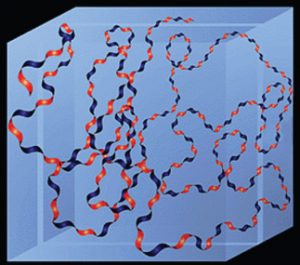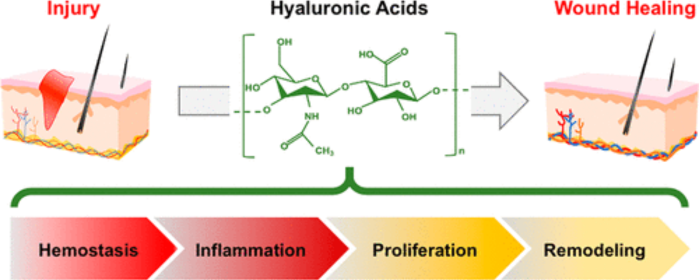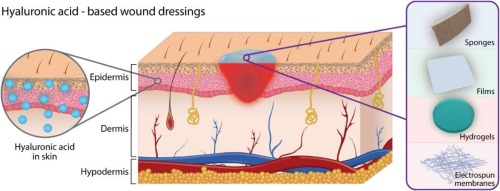Why Hyaluronic Acid is an Ideal Material for Wound Healing
Normal wound healing involves stages such as hemostasis, inflammation, proliferation, and remodeling. Throughout these stages, hyaluronic acid plays an active role, hence it qualifies as an ideal material for wound healing.
What is Hyaluronic Acid
Hyaluronic acid (Hyaluron, HA) is a naturally occurring polysaccharide molecule found in humans and other organisms. It is widely distributed in the human body, primarily present in the skin, joint fluid, eyes, and connective tissues.
HA Structure
The basic structure of hyaluronic acid consists of two types of sugar molecules arranged alternately:
- D-Glucuronic Acid (GlcA)
- N-Acetyl-D-Glucosamine (GlcNAc)
These two monosaccharides are alternately connected with β-1,3 and β-1,4 glycosidic linkages to disaccharide repeating units. This specific linkage allows HA to possess a linear, unbranched conformation, which avoids branching and complex three-dimensional arrangements, ensuring its high water capacity and fluidity. The carboxyl and hydroxyl groups provide opportunities for HA chemical modification. Hence, it can be synthesized into various hydrogels, fillers, and biomedical materials for various applications.
Fig 1. Hyaluronan hydrophilic properties[1]
HA Physiological Functions
As mentioned earlier, hyaluronic acid exists in tissues such as the skin, joints, and eyes in the human body, where it performs important functions:
- Skin: Protects the moisture and elasticity of the skin, softens wrinkles, and delays aging.
- Joints: Lubricates joints, reduces friction, and alleviates arthritis symptoms.
- Eyes: Aids in maintaining the shape and lubrication of the eyeball.
Besides this, hyaluronic acid also serves an important physiological function of wound healing.
Why Hyaluronic Acid Can Heal Wounds
Hyaluronic acid is naturally present in the human body. Endogenous HA and exogenous HA are chemically extremely close. Therefore, the application of hyaluronic acid products in wound healing reduces immune system recognition and rejection reactions. Furthermore, HA is a biodegradable compound, which is degraded by hyaluronidases over time, preventing the accumulation and potential toxicity of the compound in the body. In general, hyaluronic acid is safe, non-toxic, and bio-metabolizable, providing the foundation for it to act as a material in wound healing.
Of course, biocompatibility is just a foundation; the important thing is that hyaluronic acid plays in a number of different functions during the wound healing process through various mechanisms.
Fig 2. Wound healing process[2]
1. Hemostasis
Hemostasis is the first step in wound healing. The mechanism of hemostasis is to stop bleeding by platelet aggregation and blood clotting, sealing the wound from infection. HA can bind to CD44 receptors on the platelet surface, promoting platelet activation and aggregation, and blood clot formation. In addition, HA’s high molecular weight and viscoelasticity allow it to form a viscous physical barrier on the wound surface, restricting blood loss.
2. Inflammatory Phase
During this phase, inflammatory mediators are released so that leukocytes and other immune cells can migrate into the wound site. They suppress infection, debride the wound, and create good conditions for tissue repair and regeneration. During this phase, the primary role of HA is to induce the migration and proliferation of inflammatory cells. While this increases the inflammatory response, exogenous HA also has anti-inflammatory activity. Some studies show that exogenous HA has been found to reduce the infiltration of inflammatory cells and decrease the inflammatory response. In conclusion, HA guarantees the wound healing is enhanced by the optimal amount of inflammation.
3. Proliferation Phase
The proliferation phase is the critical phase of healing wounds, including angiogenesis, epithelial cell migration and proliferation, and repair of extracellular matrix. During this phase, HA plays a range of roles:
- Promotes Cell Migration and Development: HA triggers fibroblast and epithelial cell proliferation, enabling the wound to close rapidly.
- Promotes Angiogenesis: HA stimulates the growth of new blood vessels to supply new tissue with oxygen and nutrients.
- Enables Extracellular Matrix Development: HA stimulates the production of collagen, reconstitutes tissue structure, and enhances wound strength.
- Retains the Wound Moist: HA keeps the wound in a moist state to enable cell functioning and infection prevention, thereby accelerating healing.
4. Remodeling Phase
The remodeling stage is the final phase of the healing process. In this stage, HA takes part in control of reorganization of collagen to make tissue tougher and elastic as well as preclude scar formation. The previously mentioned anti-inflammatory properties of HA continue to play a role in this phase. It can reduce local inflammation in the wound, promoting the recovery of healthy tissue. Moreover, HA can also promote the synthesis of elastin. With the support of elastin, the healed skin experiences less tightness, restoring its original elasticity and flexibility.
What are the Hyaluronic Acid-Based Dressings
Given the powerful healing property of hyaluronic acid, how can researchers disregard it? Its most common applications are HA-based dressings.
Hyaluronic acid dressings are medical wound-covering agents composed of sodium hyaluronate (sodium salt of HA) that provide an extremely conducive microenvironment for wound repair. They can also be blended with other substances, such as antimicrobial silver ions, collagen, chitosan, etc. Depending on the applications, they exist in various forms.
Fig 3. Hyaluronic Acid-Based Dressings[3]
1. Hyaluronic Acid Hydrogel Dressings
Hyaluronic acid hydrogels are the most advanced and versatile type of HA dressings. They are formed through physical or chemical crosslinking, yielding a three-dimensional network hydrophilic gel. They provide a stable moist environment, allowing cell migration and growth. Stable hyaluronic acid hydrogels, for example, can be formed by carbodiimide hydrochloride and adipic dihydrazide crosslinking.
* Suitable for chronic ulcers and burns.
2. Hyaluronic Acid Sponge Dressings
These are highly porous, absorbent dressings. Like a sponge, they are able to suck out excess exudate and prevent maceration. They provide physical support as well, which prevents overgrowth of granulation tissue. They are some of them are mixed with chitosan to enhance antibacterial activity.
* Suitable for highly exudative wounds and postoperative bleeding wounds.
3. Hyaluronic Acid Film Dressings
The most significant benefit of film dressings is their thinness and breathability. With a thickness as low as 0.01~0.1mm, they provide excellent breathability. They are also convenient to apply, sticking to the wound surface without needing secondary fixation.
* Suitable for minimally invasive facial surgeries.
4. Hyaluronic Acid Sprays
These are dressing items that trap sodium hyaluronate in liquid form in pressurized cans or pump bottles, which are applied directly to the skin or wound surface as a spray. Their key features include ease of use, immediate moisturization, and rapid film formation. Medical sprays can also be employed to deliver antibiotics or cytokines for selective drug delivery.
* Suitable for large-area burns and oral/nasal mucosal ulcers.
Other than these traditional dressings, with technology increasing, the market also launched 3D-printed custom dressings. These use a bio-ink composed of HA and fibroblasts to print active dressings with precise matching of the wound contour. They can replicate complicated wounds in a very accurate manner, for instance, nasal defects repair.
Stanford Chemicals Company (SCC) offers high-quality hyaluronic acid (HA) powder raw materials suitable for the pharmaceutical, cosmetic, and research industries. Their HA powder is characterized by high purity, excellent solubility, and a variety of molecular weight options, ensuring outstanding performance across different applications. Whether you need it for moisturizing formulations, injectable fillers, eye drops, or medical dressings, SCC can meet your requirements. For more product information, contact professionals through the Get A Quote.
[1] Frenkel JS. The role of hyaluronan in wound healing. Int Wound J. 2014 Apr;11(2):159-63. doi: 10.1111/j.1742-481X.2012.01057.x. Epub 2012 Aug 14. PMID: 22891615; PMCID: PMC7950635.
[2] Polizzi, A.; Leanza, Y.; Belmonte, A.; Grippaudo, C.; Leonardi, R.; Isola, G. Impact of Hyaluronic Acid and Other Re-Epithelializing Agents in Periodontal Regeneration: A Molecular Perspective. Int. J. Mol. Sci. 2024, 25, 12347. https://doi.org/10.3390/ijms252212347
[3] Mariana F.P. Graça, Sónia P. Miguel, Cátia S.D. Cabral, Ilídio J. Correia, Hyaluronic acid—Based wound dressings: A review, Carbohydrate Polymers, Volume 241, 2020, 116364, ISSN 0144-8617, https://doi.org/10.1016/j.carbpol.2020.116364.



